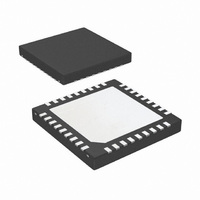LP5551SQX/NOPB National Semiconductor, LP5551SQX/NOPB Datasheet - Page 27

LP5551SQX/NOPB
Manufacturer Part Number
LP5551SQX/NOPB
Description
IC ENERGY MGMNT SYSTEM 36-LLP
Manufacturer
National Semiconductor
Series
PowerWise®r
Datasheet
1.LP5551SQXNOPB.pdf
(32 pages)
Specifications of LP5551SQX/NOPB
Applications
Handheld/Mobile Devices
Current - Supply
431µA
Voltage - Supply
2.7 V ~ 5.5 V
Operating Temperature
-40°C ~ 85°C
Mounting Type
Surface Mount
Package / Case
36-LLP
For Use With
LP5551SQEV - BOARD EVALUATION LP5551SQ
Lead Free Status / RoHS Status
Lead free / RoHS Compliant
Other names
LP5551SQX
Application Information
PWM/PFM FORCE REGISTER (R9)
By default, the LP5551 automatically transitions between
PFM and PWM to optimize efficiency. The PWM/PFM force
register (R9) provides the option to override the automatic
transition and force PFM or PWM operation (see R9 – PWM/
PFM Force Register declaration). Note that if the operating
mode of the regulator is forced to be PFM then the switch
current limit is reduced to 100 mA (50 mA average load cur-
rent).
EN/RESETN
The LP5551 can be shutdown via the ENABLE or RESETN
pins, or by issuing a shutdown command from PWI. To dis-
able the LP5551 via hardware (as opposed to the PWI shut-
down command), pull the ENABLE and/or the RESETN pin
(s) low. To enable the LP5551, both the ENABLE and the
RESETN pins must be high. Once enabled, the LP5551 en-
gages the power-up sequence and all voltages return to their
default values.
When using PWI to issue a shutdown command, the PWI will
be disabled along with the regulators in the LP5551. To re-
enable the part, either the ENABLE, RESETN, or both pins
must be toggled (high – low – high). The part will then enter
the power-up sequence and all voltages will return to their
default values. Figure 8 summarizes the ENABLE/RESETN
control.
The ENABLE and RESETN pins provide flexibility for system
control. In larger systems such as a mobile phone, it can be
advantageous to enable/disable a subsystem independently.
For example, the LP5551 may be powering the applications
processor in a mobile phone. The system controller can pow-
er down the applications processor via the ENABLE pin, but
leave on other subsystems. When the phone is turned off or
in a fault condition, the system controller can have a global
reset command that is connected to all the subsystems (RE-
SETN for the LP5551). However, if this type of control is not
needed, the ENABLE and RESETN pins can be tied together
and used as a single enable/disable pin.
FIGURE 8. ENABLE and RESETN operation
20172151
27
INDUCTOR
A 4.7uH inductor should be used with the LP5551. The in-
ductor should be rated to handle the peak load current plus
the ripple current:
CURRENT LIMIT
The switching converter in the LP5551 detects the peak in-
ductor current and limits it for protection (see Electrical Char-
acteristics table and/or Typical Performance section). To
determine the average current limit from the peak current lim-
it, the inductor size, input and output voltage, and switching
frequency must be known. The LP5551 is designed to work
with a 4.7uH inductor, so:
INPUT CAPACITOR
The input capacitor to the switching converter supplies the AC
switching current drawn from the switching action of the in-
ternal power FETs. The input current of a buck converter is
discontinuous, so the ripple current supplied by the input ca-
pacitor is large. The input capacitor must be rated to handle
this current:
The power dissipated in the input capacitor is given by:
The input capacitor must be rated to handle both the RMS
current and the dissipated power. A 22 µF ceramic capacitor
is recommended for the LP5551.
OUTPUT CAPACITOR
The switching converters in the LP5551 are designed to be
used with a 22uF ceramic output capacitor. The dielectric
should be X5R, X7R, or comparable material to maintain
proper tolerances. The output capacitor of the switching con-
verter absorbs the AC ripple current from the inductor and
provides the initial response to a load transient. The ripple
voltage at the output of the converter is the product of the
ripple current flowing through the output capacitor and the
impedance of the capacitor. The impedance of the capacitor
can be dominated by capacitive, resistive, or inductive ele-
ments within the capacitor, depending on the frequency of the
www.national.com











